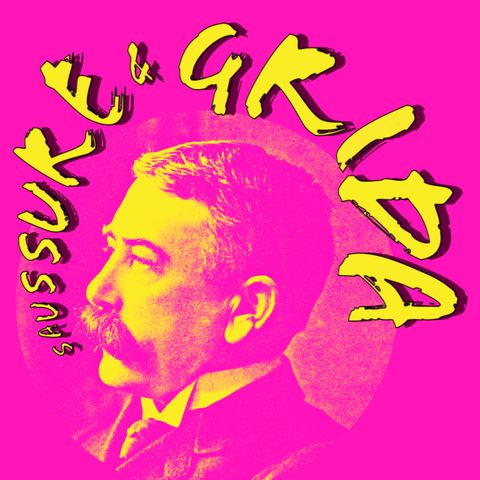15. Come si impara un'altra lingua? Di interlingua, emisferi e giochi

Download and listen anywhere
Download your favorite episodes and enjoy them, wherever you are! Sign up or log in now to access offline listening.
Description
In questa puntata vediamo il processo di apprendimento linguistico e le teorie che lo circondano. Parliamo di interlingua, un concetto chiave nello studio dell'acquisizione, e di emisferi cerebrali e di...
show moreGrafiche: Gianluca La Bruna
La sigla è stata prodotta da White Hot e fornita da https://freebeats.io
Fonti:
- Beaumont, J.G. (2008). "Chapter 7". Introduction to Neuropsychology (Second ed.). The Guilford Press.
- Burghardt, G.M. (2005). The genesis of animal play: Testing the limits. Cambridge, MA: MIT Press.
- Cai, Q., Haegen, L., & Brysbaert, M. (2013). Complementary hemispheric specialization for language production and visuospatial attention. Proceedings of the National Academy of Sciences of the United States of America, 110(4):1158-1159.
- Clahsen, H., & Felser, C. (2006). Grammatical processing in language learners. Applied Psycholinguistics, 27(1):3–42.
- Chini, M. (2001). Che cos'è la linguistica acquisizionale. Roma: Carocci.
- Cohen, A.D. (1982). Neurolinguistics and second language acquisition. TESOL Quarterly, 16(3):305-306.
- Congmin, Z. (2022). Hemispheric Lateralization and Language Learning: Neurolinguisitc Considerations. Sino-US English Teaching, 19(6)204-208.
- Ellis, R. (2005). Measuring implicit and explicit knowledge of a second language: A psychometric study. Studies in Second Language Acquisition. 27(2):141–172
- Fodor, J. (1980). Fixation of belief and concept acquisition. In M. Piattelli-Palmarini (Ed.), Language and learning: The debate between Jean Piaget and Noam Chomsky. Cambridge, MA: Harvard University Press.
- Han, Z.H.; Baohan, A. (2023). Age and attainment in foreign language learning: The critical period account stands. Brain and Language 246:105-343.
- Kilgard, M.P. (1998). "Plasticity of temporal information processing in the primary auditory cortex". Nature Neuroscience. 1(8):727–731.
- Lantolf, J.P., & Beckett, T.G. (2009). Sociocultural theory and second language acquisition. Language Teaching. 42(4):459–475.
- Lenneberg, E.H. (1967). Biological Foundations of Language. New York: Wiley.
- Loewen, S., & Reinders, H. (2011). Key concepts in second language acquisition. Houndmills, Basingstoke, Hampshire: Palgrave Macmillan.
- Nebes, R.D. (1978). Direct examination of cognitive functions in the right and left hemispheres. In M. Kinsbourne (Ed.), Asymmetrical functions of the brain. New York: Cambridge UP.
- Pellegrini, A.D., Dupuis, D., & Smith, P.K. (2007). Play in evolution and development. Developmental Review, 27(2):261–276.
- Pienemann, M. (1998). Language processing and second language development: Processability theory. Amsterdam: John Benjamins.
- Ramscar, M., & Gitcho, N. (2007). Developmental change and the nature of learning in childhood. Trends in Cognitive Sciences. 11(7):274–279.
- Rastelli, S. (2018). Neurolinguistics and second language teaching: A view from the crossroads. Second Language Research, 34(1), 103–123.
- Reinders, H. (2011). Key concepts in second language acquisition. Houndmills, Basingstoke, Hampshire: Palgrave Macmillan.
- Riès, S.K.; Dronkers, N.F.; Knight, R.T. (2016). Choosing words: left hemisphere, right hemisphere, or both? Perspective on the lateralization of word retrieval. Annals of the New York Academy of Sciences. 1369(1):111–131.
- Rogers, L.J. (2021). Brain Lateralization and Cognitive Capacity. Animals. 11(7):1996.
- Seliger, H.W. (1982). On the possible role of the right hemisphere in second language acquisition. TESOL Quarterly, 16(3):307-314.
- Schmidt, R. (1990). The role of consciousness in second language learning. Applied Linguistics, 11(2):129–158.
- Schmidt, R. (2002). Interaction hypothesis. In J. Richards & R. Schmidt (Eds.). Longman dictionary of language teaching and applied linguistics. London New York: Longman.
- Singleton, D., & Lengyel, Z. (Eds.) (1995). The age factor in second language acquisition: a critical look at the critical period hypothesis. Clevedon, UK: Philadelphia.
- Snow, C.E., & Hoefnagel-Hohle, M. (1978). The Critical Period for Language Acquisition: Evidence from Second Language Learning. Child Development. 49(4):1114-1128.
- Taylor I., & Taylor, M.M. (1990). Psycholinguistics: Learning and using Language. Pearson.
- Tarone, E. (2001). Interlanguage. In R. Mesthrie (Ed.). Concise Encyclopedia of Sociolinguistics. (475–481) Oxford: Elsevier Science.
- Thompson, R. A. (1984). Language, the brain, and the question of dichotomies. American Anthropologist, New Series, 86(1):98-105.
- Walker, L.C. (1981). The Ontogeny of the Neural Substrate for Language. Journal of Human Evolution 10(5):429–441.
Information
| Author | Irene |
| Organization | Irene Lami |
| Website | - |
| Tags |
Copyright 2024 - Spreaker Inc. an iHeartMedia Company

Comments